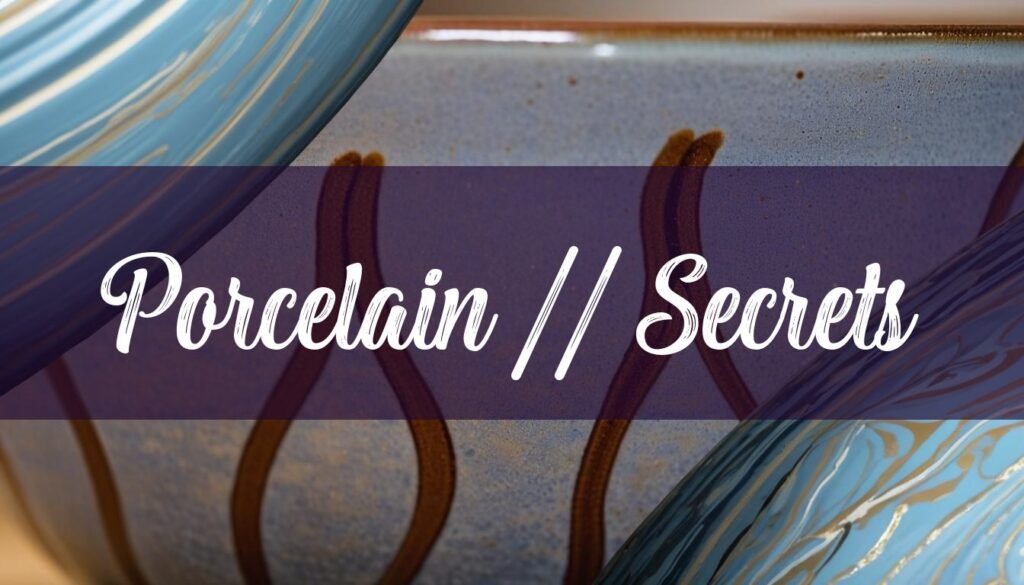Porcelain, often synonymous with “china,” stands as a distinguished member of the ceramic family, celebrated for its exquisite white appearance and remarkable translucence. What sets porcelain apart from other ceramics, such as stoneware or earthenware, is its unique composition and the high firing temperatures required to achieve its characteristic properties. Typically, porcelain consists of a blend of kaolin, a pure white clay mineral, along with feldspar and silica. When fired at temperatures ranging from 1,200°C to 1,400°C (2,192°F to 2,552°F), these materials undergo vitrification, transforming into a dense, non-porous, and remarkably durable substance. The result is a material that is not only aesthetically pleasing but also highly resistant to chemical attack and thermal shock.
There are primarily three types of porcelain: hard-paste, soft-paste, and bone china. Hard-paste porcelain, often referred to as “true porcelain,” is the original and most widely used type, known for its exceptional durability and resistance to cracking when exposed to hot liquids. Soft-paste porcelain, also called “artificial porcelain,” is weaker and requires lower firing temperatures. Its ingredients can vary but typically include clay and ground glass. Bone china, distinguished by its inclusion of bone ash, is celebrated for its high levels of translucency and whiteness, making it one of the strongest varieties of whiteware ceramics. The bone ash provides extra strength, allowing potters to create thinner and more delicate pieces, fired at slightly lower temperatures to achieve a milky transparency. If you’re curious about the types of clay used in ceramics, you might find this guide helpful.
The distinction between porcelain and other ceramics lies in the specific blend of raw materials and the extreme temperatures at which they are fired. This process results in a vitrified body that is dense, hard, and translucent, characteristics not typically found in other types of ceramics. While traditional china and porcelain share similarities, bone china’s addition of bone ash lends it a unique translucency and delicate appearance, often favored for upscale dining experiences. Despite its fragile presentation, bone china is known as the strongest and most durable ceramic dinnerware available. Whether it’s the original hard-paste, the more delicate soft-paste, or the elegant bone china, each type of porcelain offers a unique blend of beauty and functionality, making it a prized material for a wide range of applications.
The Rich History of Porcelain
The history of porcelain is a captivating journey that begins in China, where it was first developed and refined over centuries. The Chinese were the first to master the art of creating hard-paste porcelain, utilizing their abundant resources of kaolin clay and high-temperature kilns. By the 14th century, Chinese porcelain had made its way to Europe, where its beauty and durability astonished Europeans, who were captivated by its seemingly magical qualities. These early encounters sparked a fervent desire among European artisans to replicate this remarkable material.
However, the Europeans initially lacked the essential knowledge and resources, particularly access to high-quality kaolin clay and the technology to achieve the necessary high firing temperatures. This led to the development of soft-paste porcelain, an attempt to mimic the appearance of hard-paste porcelain using different materials and lower firing temperatures. One of the most successful factories producing soft-paste porcelain was Royal Worcester, established in 1751. Despite these efforts, soft-paste porcelain remained weaker and less durable than its Chinese counterpart. The breakthrough came in 1710 when the Meissen factory in Germany successfully replicated hard-paste porcelain, closely guarding their recipe to maintain a competitive edge.
Another significant development in the history of porcelain is the creation of bone china. In England, Thomas Frye pioneered this type of porcelain in an attempt to recreate Chinese hard-paste porcelain. By incorporating bone ash into the porcelain mixture, Frye discovered that the resulting material was stronger, more translucent, and could be fired at a lower temperature. Ironically, despite its European origins, bone china has gained immense popularity and has even surpassed hard-paste porcelain production in China today. This rich history showcases porcelain’s journey from its ancient origins in China to its global prominence, highlighting the ingenuity and innovation that have shaped its evolution.
The Manufacturing Process of Porcelain
The creation of porcelain is a complex and meticulous process that transforms raw materials into objects of beauty and utility. It begins with the careful selection and preparation of raw materials, typically including kaolin clay, feldspar, and silica. These materials are first crushed into smaller pieces using jaw crushers, hammer mills, and ball mills. The goal is to reduce the raw material particles to the desired size, ensuring a consistent and smooth mixture. The crushed materials are then cleaned to remove any impurities or improperly sized particles, ensuring the final product is of the highest quality.
The next stage involves forming the porcelain body into the desired shape. There are several methods for achieving this, including soft plastic forming, stiff plastic forming, pressing, and slip casting, each suited to different types of ware. Soft and stiff plastic forming involve shaping the clay while it is pliable, while pressing uses high pressure to mold the clay into the desired form. Slip casting, on the other hand, involves pouring a liquid clay mixture (slip) into a mold and allowing it to harden. Once the porcelain has been formed, it undergoes a preliminary firing known as bisque-firing. This firing step, done at a relatively low temperature, helps to vaporize any volatile contaminants and minimizes shrinkage during the final firing. After bisque firing, the porcelain wares are put through a glazing operation, which applies the proper coating. The glaze can be applied by painting, dipping, pouring, or spraying. If you’re interested in making your own glaze, here’s a guide on how to make your own glaze for pottery.
The final and most critical step in the manufacturing process is firing the porcelain at a very high temperature. This can be done in either a periodic kiln or a tunnel kiln, each designed to maintain precise temperature zones throughout the firing process. During firing, carbon-based impurities burn out, chemical water evolves, and minerals break down to form liquid glasses. These glass phases are essential for shrinking and bonding the grains, ultimately giving porcelain its strength and translucence. After cooling, the porcelain is complete, showcasing its characteristic hardness, density, and exquisite appearance. The combination of meticulous material preparation, careful forming techniques, and high-temperature firing results in a product that is both beautiful and durable.





